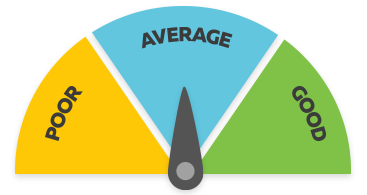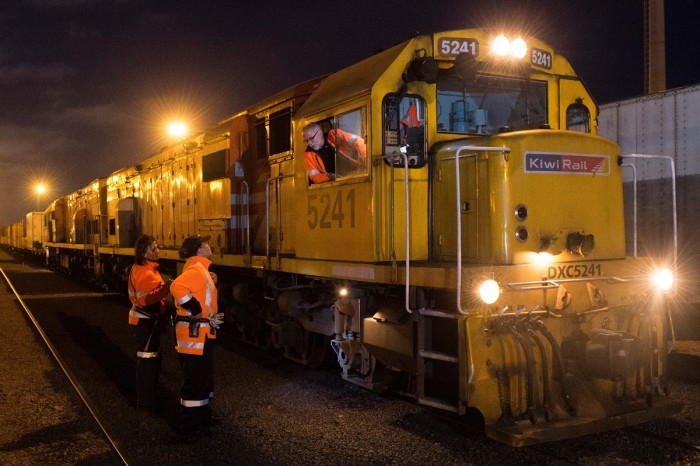Train Driver
Kaitaraiwa Rerewhenua
Alternative titles for this job
Train drivers drive passenger or freight trains. They may shift (shunt) carriages and wagons using trains or remote controls.
Pay
Train drivers usually earn
$45-$57 per hour
Train drivers can earn
$37-$62 per hour
Source: TEC research
Job opportunities
Pay
Pay for train drivers varies depending on their experience and role.
- Train drivers usually earn $45 to $57 an hour.
- Train drivers can earn $37 to $62 an hour.
Shift work and overtime increases their take-home pay.
Source: TEC research.
(This information is a guide only. Find out more about the sources of our pay information)
What you will do
Train drivers may do some or all the following:
- drive trains, either in cabs or with remote controls
- keep to schedules, and stop at stations to pick up or drop off passengers
- link and unlink carriages and wagons
- drive a locomotive (train engine) or use remote controls to shunt (push or pull) carriages and wagons to make up new trains
- check locomotives
- read about maintenance work happening on the tracks they drive on, and any rule changes
- operate points (levers that switch tracks)
- communicate with train control, other drivers and shunters, and passengers
- prepare documents about wagon loads
- act promptly and comply with safety rules during emergencies or breakdowns
- identify and fix or report faults with their equipment.
Skills and knowledge
Train drivers need to have knowledge of:
- emergency and safety procedures and first aid
- how to operate a locomotive (train engine) and its mechanics, including air brakes and electrics
- rail-operating codes and signals
- safety rules and regulations
- the correct way to use radio equipment
- shunting (pushing and pulling carriages and wagons using trains or remote controls).
Working conditions
Train drivers:
- do shift work, including nights and public holidays
- work in drivers' cabs, outside in railway yards, and on train tracks in all weather
- work in confined spaces and conditions that are hazardous (because they work with large machinery), and sometimes stressful (because there is a risk of hitting cars, animals or people on the tracks)
- travel within or between cities each day.
What's the job really like?
Train driver video
Train drivers talk about the highlights and challenges of their job – 1.35 mins. (Video courtesy of KiwiRail)
Second train driver: I like the challenge of a heavy long train over a challenging track. There's a good sense of achievement when you get to the other end.
Third train driver: It's different, because you are not stuck in an office from 9 to 5, you're out there and every day's different – it's never the same.
Fourth train driver: I've always wanted to be a train driver.
Fifth train driver: You're pretty much your own boss.
Second train driver: For me, the least favourite route has got to be the suburban area, because of the volume of people – people at the side of the track, people on platforms, people on level crossings and unfortunately a lot of people don't have situational awareness about what's going on. So often we see them with earphones in, and a cellphone in front of them
First train driver: Yeah, with the earphones, they just can't hear the bells.
Fifth train driver: I'm lucky, so far not to have been involved in an actual incident, but I've had lots and lots of countless near misses.
Second train driver: Your heart goes into your mouth, you reach for the brake, you know that if something goes wrong you're not going to stop.
Fourth train driver: Before you cross over the tracks, remember, always.
Second train driver: Always.
Third train driver: Always.
Fifth train drive: Always expect trains, in either direction, at any time.
Entry requirements
Becoming a train driver
You need to learn on the job and get a qualification to become a train driver.
You need:
- to complete on-the-job training courses
- a New Zealand Certificate in Rail Operations (Train Driver) (Level 4)
- a driver licence
- to pass a medical assessment and drug test
- to pass a police check
- a First Aid Certificate.
You may need:
- a rail licence.
Becoming a shunter
To become a shunter, who shifts (shunts) carriages and wagons using trains or remote controls, you need to:
- pass a basic entry test and a medical test, which includes drug testing
- take training and induction courses run by KiwiRail.
Secondary education
You usually need NCEA Level 2 to do the study or training for this job. Maths, English, and construction and mechanical technologies to at least NCEA Level 2 are useful.
For Year 11 to 13 students, the Gateway programme is a good way to to gain industry experience. This programme may help you gain a job but doesn't reduce the amount of time it takes to complete your training.
Personal requirements
Train drivers need to be:
- safety-conscious
- able to stay alert for long periods while working alone
- punctual
- able to think ahead and anticipate problems
- able to stay calm under pressure and in emergencies
- good communicators, in person and by radio.
Useful experience
Useful experience for train drivers includes:
- physical work in a setting where safety is important
- work in a shunting yard or other train-related work
- mechanical or engineering work.
Physical requirements
Train drivers need to have:
- good hearing and eyesight (with or without corrective lenses)
- accurate colour vision to correctly recognise signals and other instructions
- good reflexes
- excellent fitness and health, and good strength as they need to lift train parts that can weigh up to 25 kilograms.
They also need to be comfortable working in confined spaces.
Find out more about training
- KiwiRail
- careers@kiwirail.co.nz - www.kiwirail.co.nz
- Transdev
- www.transdev.co.nz
What are the chances of getting a job?
Demand for train drivers average, but expected to increase
Opportunities for train drivers are average because a number of train drivers are retiring, which creates vacancies, but competition for positions is high.
However, opportunities for train drivers are expected to increase in the long term. This is because the 2018-27 Government Policy Statement on Land Transport includes up to $400 million for rail improvements, including more commuter rail services and more rail freight trips.
According to the Census, 1,134 train drivers worked in New Zealand in 2018.
Most train driver work is in Auckland and Wellington
Your chances of getting train driver work are best in Auckland and Wellington, which have major freight depots and urban commuter networks.
The Auckland City Rail Link will increase demand for train drivers in Auckland as it will extend the network and allow more trains to travel on all lines. One hundred new train drivers will be needed.
KiwiRail recruits train drivers in Hamilton, Palmerston North and Christchurch for freight operations.
Shunter opportunities limited
Shunters, who shift (shunt) carriages and wagons using trains or remote controls, tend to leave the role after a short time because the role is physically demanding.
However, the occupation is small so it can still be difficult to secure a position.
Two employers of train drivers
Train drivers work for:
- KiwiRail – driving freight and long-distance passenger trains
- Transdev – driving local Auckland and Wellington commuter trains.
Sources
- Dunkin, V, talent acquisition manager, KiwiRail, careers.govt.nz interview, October 2018.
- KiwiRail website, accessed September 2018, (www.kiwirail.co.nz).
- Maskell, L, senior recruitment consultant, Transdev Auckland, careers.govt.nz interview, October 2018.
- New Zealand Transport Agency, 'Draft Transport Agency Investment Proposal 2018-27', April 2018, (nzta.govt.nz).
- Stats NZ, '2018 Census Data', 2019.
- Transdev website, accessed September 2018, (transdev.co.nz).
- Wilson, S, 'Auckland City Rail Link to be Bigger and More Expensive', 24 July 2018, (www.nzherald.co.nz).
(This information is a guide only. Find out more about the sources of our job opportunities information)
Progression and specialisations
Experienced train drivers may move into managerial or training roles. They may also progress to become station managers or train controllers.
Last updated 13 December 2024


